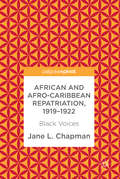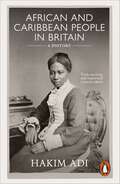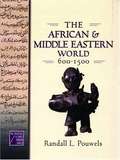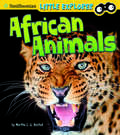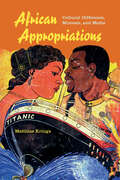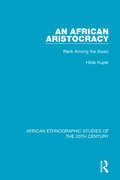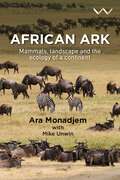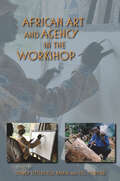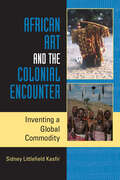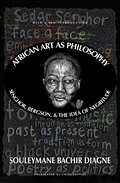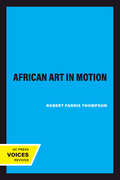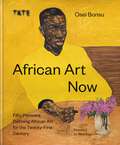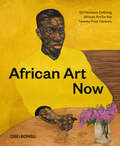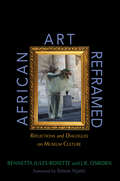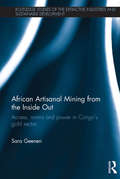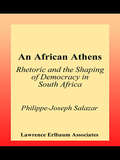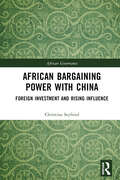- Table View
- List View
African and Afro-Caribbean Repatriation, 1919–1922: Black Voices
by Jane L. ChapmanThis book is the first attempt to analyse records of people of Afro-Caribbean origin who appealed against repatriation during the painful period after Britain’s 1919 race riots. Revealing personal letters and petitions from the West Indies, West Africa, and the UK, Jane Chapman demonstrates that conflict adjustment involving individual voices needs to be highlighted. She asks, what was the human environment, the dilemmas and the racist compulsions making transnational experiences in the British Empire so poignant? Analysing both the opinions of civil servants on appellants’ statements of hardship and requests for financial help, and the voices of the appellants themselves, this book aims to rediscover black people’s hidden heritage.
African and Caribbean People in Britain: A History
by Hakim AdiSHORTLISTED FOR THE WOLFSON HISTORY PRIZE A major new history of Britain that transforms our understanding of this country's past'I've waited so long so read a comprehensively researched book about Black history on this island. This is it: a journey of discovery and a truly exciting and important work' Zainab Abbas Despite the best efforts of researchers and campaigners, there remains today a steadfast tendency to reduce the history of African and Caribbean people in Britain to a simple story: it is one that begins in 1948 with the arrival of a single ship, the Empire Windrush, and continues mostly apart from a distinct British history, overlapping only on occasion amid grotesque injustice or pioneering protest.Yet, as acclaimed historian Hakim Adi demonstrates, from the very beginning, from the moment humans first stood on this rainy isle, there have been African and Caribbean men and women set at Britain's heart. Libyan legionaries patrolled Hadrian's Wall while Rome's first 'African Emperor' died in York. In Elizabethan England, 'Black Tudors' served in the land's most eminent households while intrepid African explorers helped Sir Francis Drake to circumnavigate the globe. And, as Britain became a major colonial and commercial power, it was African and Caribbean people who led the radical struggle for freedom - a struggle which raged throughout the twentieth century and continues today in Black Lives Matter campaigns.Charting a course through British history with an unobscured view of the actions of African and Caribbean people, Adi reveals how much our greatest collective achievements - universal suffrage, our victory over fascism, the forging of the NHS - owe to these men and women, and how, in understanding our history in these terms, we are more able to fully understand our present moment.
The African and Middle Eastern World, 600-1500 (The Medieval and Early Modern World #2)
by Randall L. PouwelsThe history of the African and Middle Eastern world is, to some extent, the story of a religion. First proclaimed by the prophet Muhammad in the seventh century, Islam claimed millions of followers. Through trade, conquest, and diplomacy, Muslim rule spread quickly from the Arabian Peninsula to Asia, Africa, and parts of Europe. But not everyone in this world practiced Islam. Muslim rulers respected Jewish and Christian traditions. And despite their empire's long reach, the caliphs' power never extended over most Africans, such as the Bini of the West African forest or the Shona of Southern Africa, who lived by local custom and beliefs.
African Animals
by Martha Elizabeth Hillman RustadTrumpeting elephants! Towering giraffes! Discover the animals slithering, stalking, and stampeding through the jungles and grasslands of Africa.
African Appropriations: Cultural Difference, Mimesis, And Media
by Matthias KringsWhy would a Hollywood film become a Nigerian video remake, a Tanzanian comic book, or a Congolese music video? Matthias Krings explores the myriad ways Africans respond to the relentless onslaught of global culture. He seeks out places where they have adapted pervasive cultural forms to their own purposes as photo novels, comic books, songs, posters, and even scam letters. These African appropriations reveal the broad scope of cultural mediation that is characteristic of our hyperlinked age. Krings argues that there is no longer an "original" or "faithful copy," but only endless transformations that thrive in the fertile ground of African popular culture.
African Archaeology Without Frontiers: Papers from the 2014 PanAfrican Archaeological Association Congress
by Chapurukha M Kusimba Santores Tchandeu Dirk Seidensticker Adrianne Daggett Marilee Wood Laure Dussubieux Tim Forssman Kate Smuts Nick Wiltshire Akin Ogundiran Matthew Davies Caleb Adebayo Folorunso Timothy Kipkeu Kipruto Freda M’Mbogori Henrietta L Moore Emubosa Orijemie Alex Schoeman Festo W Gabriel Elinaza Mjema Philip de Barros Gabriella Lucidi NarcisseConfronting national, linguistic and disciplinary boundaries, contributors to African Archaeology Without Frontiers argue against artificial limits and divisions created through the study of ‘ages’ that in reality overlap and cannot and should not be understood in isolation. Papers are drawn from the proceedings of the landmark 14th PanAfrican Archaeological Association Congress, held in Johannesburg in 2014, nearly seven decades after the conference planned for 1951 was re-located to Algiers for ideological reasons following the National Party’s rise to power in South Africa. Contributions by keynote speakers Chapurukha Kusimba and Akin Ogundiran encourage African archaeologists to practise an archaeology that collaborates across many related fields of study to enrich our understanding of the past. The nine papers cover a broad geographical sweep by incorporating material on ongoing projects throughout the continent including South Africa, Botswana, Cameroon, Togo, Tanzania, Kenya and Nigeria. Thematically, the papers included in the volume address issues of identity and interaction, and the need to balance cultural heritage management and sustainable development derived from a continent racked by social inequalities and crippling poverty. Edited by three leading archaeologists, the collection covers many aspects of African archaeology, and a range of periods from the earliest hominins to the historical period. It will appeal to specialists and interested amateurs.
An African Aristocracy: Rank Among the Swazi
by Hilda KuperOriginally published in 1947 and reprinted with a new preface in 1961, this book is based on field studies and gives an account of the social organization of the Swazi, wiith special reference to the aristocratic structure of their society and the way in which birth and rank determine social relationships and activities. The book provides a historical picture of the Swazi and the part played by them during the period of European expansion in British and Boer conflicts in South Africa. The economic structure of a society based on agriculture and the influence exerted over every aspect of social activity by the conservative and aristocratic political hierarchy is analyzed and post-War changes and their effect upon the Swazi also reviewed.
African Ark: Mammals, landscape and the ecology of a continent
by Dr. Ara MonadjemThe story of how Africa’s mammals have helped shape the continent’s landscapes over time to support an amazing diversity of lifeAfrica is home to an amazing array of animals, including the world’s most diverse assortment of large mammals. These include the world’s largest terrestrial mammal, the African elephant, which still roams great swathes of the continent alongside a host of other well-known large mammals with hooves such as hippopotamuses, giraffes, rhinoceroses, and zebras. African Ark: Mammals, Landscape and the Ecology of a Continent tells the story of where these mammals have come from and how they have interacted to create the richly varied landscape that makes up Africa as we know it today. It gives an equal airing to small mammals, such as rodents and bats, which are often overlooked by both naturalists and zoologists in favor of their larger cousins. African Ark not only describes the diversity of African mammals and the habitats in which they live; it also explains the processes by which species and population groups are formed and how these fluctuate over time. A book on mammals would not be complete without attention placed on the impact of megafauna on the environment and the important roles they play in shaping the landscape. In this way, mammals such as elephants and rhinoceros support countless plant communities and the habitats of many smaller animals. The book brings in a human perspective as well as a conservation angle in its assessment of the interaction of African mammals with the people who live alongside them. African Ark is at once scientifically rigorous and accessible for the layperson and student alike, while drawing on the contributions of numerous zoologists, ecologists and conservationists dedicated to the understanding of Africa and its wildlife.
African Armies: Evolution And Capabilities
by Bruce E. Arlinghaus Pauline H. BakerAfrican armies have undergone significant changes since African nations won independence from colonial rule. Once mainly small constabulary forces relegated to the maintenance of internal order, these armies have become larger, more modern institutions, largely in response to growing external security threats. Previous analyses have focused on African military units as political actors, with little or no attention paid to their actual abilities and desires to perform defense functions. This study examines the evolution of African armed forces, their impact on the societies in which they operate, and their current capabilities, with special attention to their effectiveness as military institutions.
African Art and Agency in the Workshop
by Till Förster Sidney Littlefield KasfirThe role of the workshop in the creation of African art is the subject of this revelatory book. In the group setting of the workshop, innovation and imitation collide, artists share ideas and techniques, and creative expression flourishes. African Art and Agency from the Workshop examines the variety of workshops, from those which are politically driven or tourist oriented, to those based on historical patronage or allied to current artistic trends. Fifteen lively essays explore the impact of the workshop on the production of artists such as Zimbabwean stone sculptors, master potters from Cameroon, wood carvers from Nigeria, and others from across the continent.
African Art and the Colonial Encounter: Inventing A Global Commodity (African Expressive Cultures)
by Sidney Littlefield KasfirFocusing on the theme of warriorhood, Sidney Littlefield Kasfir weaves a complex history of how colonial influence forever changed artistic practice, objects, and their meaning. Looking at two widely diverse cultures, the Idoma in Nigeria and the Samburu in Kenya, Kasfir makes a bold statement about the links between colonialism, the Europeans' image of Africans, Africans' changing self representation, and the impact of global trade on cultural artifacts and the making of art. This intriguing history of the interaction between peoples, aesthetics, morals, artistic objects and practices, and the global trade in African art challenges current ideas about artistic production and representation.
African Art as Philosophy: Senghor, Bergson, and the Idea of Negritude
by Souleymane Bachir DiagneThis critically acclaimed study offers a distinct, incisive look at how Senegalese philosopher Senghor sees in African art the most acute expression of Bergson&’s philosophy.Léopold Sédar Senghor (1906–2001) was a Senegalese poet and philosopher who in 1960 also became the first president of the Republic of Senegal. In African Art as Philosophy, Souleymane Bachir Diagne uses a unique approach to reading Senghor&’s influential works, taking as the starting point for his analysis Henri Bergson&’s idea that in order to understand philosophers, one must find the initial intuition from which every aspect of their work develops. In the case of Senghor, Diagne argues that his primordial intuition is that African art is a philosophy.To further this point, Diagne looks at what Senghor called the &“1889 Revolution&” (the year Bergson&’s Time and Free Will was published), as well as the influential writers and publications of that period—specifically, Nietzsche and Rimbaud. The 1889 Revolution, Senghor claims, is what led him to the understanding of the &“Vitalism&” at the core of African religions and beliefs that found expression in the arts.
African Art in Motion
by Robert Farris ThompsonThis title is part of UC Press's Voices Revived program, which commemorates University of California Press’s mission to seek out and cultivate the brightest minds and give them voice, reach, and impact. Drawing on a backlist dating to 1893, Voices Revived makes high-quality, peer-reviewed scholarship accessible once again using print-on-demand technology. This title was originally published in 1974.
African Art, Interviews, Narratives: Bodies of Knowledge at Work (African Expressive Cultures)
by Joanna Grabski and Carol MageeJoanna Grabski and Carol Magee bring together a compelling collection that shows how interviews can be used to generate new meaning and how connecting with artists and their work can transform artistic production into innovative critical insights and knowledge. The contributors to this volume include artists, museum curators, art historians, and anthropologists, who address artistic production in a variety of locations and media to question previous uses of interview and provoke alternative understandings of art.
African Art Now
by Osei BonsuOver the past two decades contemporary African art has taken its rightful place on the world stage. Today, African artists work outside the confines of limiting categories and outdated perceptions; they produce art that is as much a reflection of Africa's tumultuous past as it is a vision of its boundless future. African Art Now is an expansive overview featuring some of the most interesting and innovative artists working today. Far-reaching in its scope, this book celebrates the diversity and dynamism of the contemporary African art scene across the continent today.Featuring the work of Njideka Akunyili Crosby, Michael Armitage, Amoako Boafo, Cassi Namoda, Cinga Samson, Zina Saro-Wiwa and many more.
African Art Now
by Osei BonsuOver the past two decades contemporary African art has taken its rightful place on the world stage. Today, African artists work outside the confines of limiting categories and outdated perceptions; they produce art that is as much a reflection of Africa's tumultuous past as it is a vision of its boundless future. African Art Now is an expansive overview featuring some of the most interesting and innovative artists working today. Far-reaching in its scope, this book celebrates the diversity and dynamism of the contemporary African art scene across the continent today.Featuring the work of Njideka Akunyili Crosby, Michael Armitage, Amoako Boafo, Cassi Namoda, Cinga Samson, Zina Saro-Wiwa and many more.
African Art Now: 50 Pioneers Defining African Art for the Twenty-First Century
by Osei BonsuThis deluxe hardcover survey, featuring profiles of 50 artists on the rise, is the definitive guide to contemporary African art.With African artists attracting sizable audience numbers to museums, setting sky-high auction records, and appearing in mainstream press, it has become impossible to overlook the cultural significance of contemporary African art today. Author and curator Osei Bonsu's engaging profiles of leading African artists—along with gorgeous full-color reproductions of their work—introduce readers to a generation of movers and shakers whose innovative artwork reflects on Africa as both an idea and an experience. Using diverse forms, languages, and expressions to articulate what it means to be a part of the world, these artists generate alternate histories and imaginative futures—work that is both personal and political, universal and incredibly specific. Their work helps define contemporary African art as a vast artistic and cultural movement.STELLAR ROSTER OF ARTISTS: Amoako Boafo, Njideka Akunyili Crosby, Tunji Adeniyi-Jones, Bronwyn Katz—from household names to up-and-coming artists, African Art Now features some of the most exciting artists working today. IMPORTANT AND TIMELY: Over the past two decades, contemporary African art has become part of the global mainstream, inspiring countless exhibitions, fairs, and auctions around the world. And yet, African art remains overlooked as an area of dedicated study due to continued academic and cultural bias. This book shines a spotlight on the artists whose wide-ranging accomplishments represent the shifting dynamics and boundless possibilities of African art today. Perfect for:Artists, art collectors, art lovers, and museumgoersEducators and studentsAnyone interested in learning about contemporary African art
African Art Reframed: Reflections and Dialogues on Museum Culture
by Bennetta Jules-Rosette J.R. OsbornOnce seen as a collection of artifacts and ritual objects, African art now commands respect from museums and collectors. Bennetta Jules-Rosette and J.R. Osborn explore the reframing of African art through case studies of museums and galleries in the United States, Europe, and Africa. The authors take a three-pronged approach. Part One ranges from curiosity cabinets to virtual websites to offer a history of ethnographic and art museums and look at their organization and methods of reaching out to the public. In the second part, the authors examine museums as ecosystems and communities within communities, and they use semiotic methods to analyze images, signs, and symbols drawn from the experiences of curators and artists. The third part introduces innovative strategies for displaying, disseminating, and reclaiming African art. The authors also propose how to reinterpret the art inside and outside the museum and show ways of remixing the results. Drawing on extensive conversations with curators, collectors, and artists, African Art Reframed is an essential guide to building new exchanges and connections in the dynamic worlds of African and global art.
African Artisanal Mining from the Inside Out: Access, norms and power in Congo’s gold sector (Routledge Studies of the Extractive Industries and Sustainable Development)
by Sara GeenenArtisanal mining is commonly associated with violent conflict, rampant corruption and desperate poverty. Yet millions of people across Sub Sahara Africa depend on it. Many of them are living in eastern Democratic Republic of Congo (DRC), home to important mineral reserves, but also to a plethora of armed groups and massive human rights violations. African Artisanal Mining from the Inside Out provides a rich and in-depth analysis of the Congolese gold sector. Instead of portraying miners and traders as passive victims of economic forces, regional conflicts or disheartening national policies, it focuses on how they gain access to and benefit from gold. It shows a professional artisanal mining sector governed by a set of specific norms, offering ample opportunities for flexible employment and local livelihood support and being well-connected to the local economy and society. It argues for the viability of artisanal gold mining in the context of weak African states and in the transition towards a post-conflict and more industrialized economy. This book will be of great interest to researchers and postgraduates studying natural resources and development as well as those in development studies, African studies, sociology, political economy, political ecology, legal pluralism, and history.
The African-Asian Divide: Analyzing Institutions and Accumulation in Kenya (New Political Economy)
by Paul VandenbergWhy have Africans not gained a more dominant position in urban manufacturing in Kenya? This question is explored through an analysis of the institutions, both formal and informal, that have affected patterns of capital accumulation in Kenya by the African and Asian (Indian) communities. Using a new institutional economics approach, this book explores the history of economic activity through the pre-colonial, colonial and post-colonial periods, including the transformative period of British rule. During the colonial period, Asians were brought in to build the railways and subsequently focused on urban-based activities. Africans, meanwhile, found it difficult to move out of agriculture. Thus, the ethnic-sectoral division of activities was entrenched by the formal laws and powers of the British. Following independence, the network and financial capital that Asians had built up allowed them to survive early attempts at the Africanization of industry. Africans, now supported by the formal institutions of the state, still found it difficult to engage in manufacturing because they lacked the informal networks that support trade and credit. The analysis is supported by the results of a contemporary survey of 120 manufacturing firms in Nairobi’s metal sector that highlight the division between smaller African firms and larger Asian ones.
An African Athens: Rhetoric and the Shaping of Democracy in South Africa (Rhetoric, Knowledge, and Society Series)
by Philippe-Joseph SalazarAn African Athens offers an analysis of a new ecology of rhetoric--the reshaping of a nation into a democracy through rhetorical means. Author Philippe-Joseph Salazar provides a general view of issues as they have taken shape in the apartheid and post-apartheid South African experience, presenting the country as a remarkable stage for playing out the great themes of public deliberation and the rise of postmodern rhetorical democracy. Salazar's intimate vantage point focuses on the striking case of a democracy won at the negotiating table and also won every day in public deliberation. This volume presents a full-scale rhetorical analysis of a democratic transformation in post-Cold War era, and provides a study of the demise of apartheid and post-apartheid from the standpoint of political and public rhetoric and communication. In doing so, it serves as a template for similar enquiries in the rhetorical study of emerging democracies. Intended for readers engaged in the study of political and public rhetoric with an interest in how democracy takes shape, An African Athens highlights South Africa as a test case for global democracy, for rhetoric, and for the relevance of rhetoric studies in a postmodern democracy.
African-Atlantic Cultures and the South Carolina Lowcountry
by Ras Michael BrownAfrican-Atlantic Cultures and the South Carolina Lowcountry examines perceptions of the natural world revealed by the religious ideas and practices of African-descended communities in South Carolina from the colonial period into the twentieth century. Focusing on Kongo nature spirits known as the simbi, Ras Michael Brown describes the essential role religion played in key historical processes, such as establishing new communities and incorporating American forms of Christianity into an African-based spirituality. This book illuminates how people of African descent engaged the spiritual landscape of the Lowcountry through their subsistence practices, religious experiences, and political discourse.
African Bank Investments Limited (A)
by Lynn Sharp Paine Will HurwitzLess than a year after joining the board of African Bank Investments Limited (ABIL), the newest director finds himself in difficult discussions with other directors about removing the struggling company's CEO. The case is set in South Africa in mid-2014 as shares in ABIL, which traded on the Johannesburg Stock Exchange, are declining precipitously. The case describes ABIL's origins and evolution, including the acquisition and growth of its wholly owned subsidiary African Bank, a provider of unsecured loans to help individuals pay for expenses such as vehicle repairs, home renovations, funeral costs, medical bills, and education. As ABIL's profits rose and share price soared, it became the darling of analysts. However, when the South African economy turned sour, customers started defaulting on their loans, and ABIL and African Bank began to struggle. As ABIL's stock price dropped, the management team faced difficult questions about the company's lending practices, risk management processes, and plans to turn the business around. By 2014, the situation was grim, and pressure mounted from shareholders and market regulators for the board to take action. The case details the history of unsecured lending in South Africa, describes the regulatory, social, and legal contexts for the company and its business model, and explores the company's unique corporate structure and executive and director dynamics.
African Bank Investments Limited (B)
by Lynn Sharp Paine Will HurwitzLess than a year after joining the board of African Bank Investments Limited (ABIL), the newest director finds himself in difficult discussions with other directors about removing the struggling company's CEO. The case is set in South Africa in mid-2014 as shares in ABIL, which traded on the Johannesburg Stock Exchange, are declining precipitously. The case describes ABIL's origins and evolution, including the acquisition and growth of its wholly owned subsidiary African Bank, a provider of unsecured loans to help individuals pay for expenses such as vehicle repairs, home renovations, funeral costs, medical bills, and education. As ABIL's profits rose and share price soared, it became the darling of analysts. However, when the South African economy turned sour, customers started defaulting on their loans, and ABIL and African Bank began to struggle. As ABIL's stock price dropped, the management team faced difficult questions about the company's lending practices, risk management processes, and plans to turn the business around. By 2014, the situation was grim, and pressure mounted from shareholders and market regulators for the board to take action. The case details the history of unsecured lending in South Africa, describes the regulatory, social, and legal contexts for the company and its business model, and explores the company's unique corporate structure and executive and director dynamics.
African Bargaining Power with China: Foreign Investment and Rising Influence (African Governance)
by Christina SeyfriedThis book provides a detailed account of the political economy around investment deal negotiations between African governments and private Chinese investors. The book draws on evidence from experiments and hundreds of interviews with policy makers and Chinese investors across Nigeria, South Africa, Kenya, Ethiopia and Tanzania. It shows that governments of authoritarian or one-party dominant states, which are among the top-receivers of Chinese investments, are able to easily and successfully act collectively to impose human capital and technology transfer requirements. The book argues that, rather than treating African countries as "price-takers" in the face of increasing Chinese influence in the continent, we should instead recognise the significant bargaining leverage that many African governments have to influence deal conditions, especially with smaller private Chinese companies. It demonstrates that several African governments can instead act "as price-setters" and that the success of the rising Chinese presence in Africa, and whether this leads to positive or negative development outcomes, fundamentally depends on the development strategies that individual African governments decide on. In the context of an often-polarised debate, the original research presented in this book has important implications for the future economic development strategies of African countries. As such, it will be of interest to researchers working on Chinese and African investment, politics, institutions, business, economics, and international relations.
